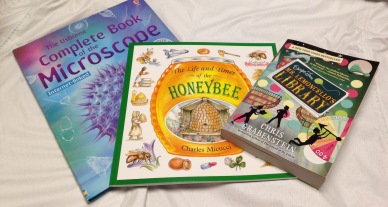Let’s pretend that you need to brush up on your knowledge of bees. May we suggest, “The Life and Times of the Honeybee” by Charles Micucci? This sort of looks like a little kids book, but every single page intrigues with surprising information – my son and I were amazed to learn that a colony of 10,000 to 60,000 bees includes only 100 male bees (the drones)…Those worker bees flitting about in gardens? The bees that sting you? The bees that make the honey? ALL female. So my son and I worked the ratios – if there are 100 males and 10,000 in the colony, the ratio of male to female is 1:100. If there are 100 males and 60,000 in the colony, the ratio is 1:600. (This ratio reminded me of the Jan and Dean hit of 1963, “Surf City” – which starts out “Two Girls for Every Boy” – so I forced my son to view a video of Jan and Dean on The Steve Allen Show. I don’t think I can get him to watch this again.)
But back to “The Life and Times of the Honeybee” – we give this bee book an A!
Blood, blood, and more blood (gross overstatement) – Just last night we were reading through “The Usborne Complete Book of the Microscope”, learning the difference between optical (vocab) and electron (vocab) microscopes. Well! This morning at a doctor’s appointment, we saw a sample of my son’s blood through the mechanism of an electron microscope! Perfect timing! The computer screen view was fascinating – from a pinprick of of blood on the glass slide, the jillions of red blood cells were so easy to see. Fabulous technology.
The Hand Thump of Appreciation – Sometimes when I read to my son and I think he is dozing off, I consider stopping for the night – and then the HAND THUMP OF APPRECIATION happens. Just as I am about to shut the book, my son’s hand comes crashing down on the page of the book, inferring VEHEMENTLY, “this is cool. KEEP READING”. This happened last night – we were reading the multi-award winning “Escape from Mr. Lemoncello’s Library” by Chris Grabenstein (a group of 12 lucky kids win the opportunity to spend the night in eccentric Mr. Lemoncello’s brand new city library). Apparently my son is really enjoying the book! YES. Happy day.
Story Problem Alert! Farmer Brown raises bees! Of course he does. This past week Farmer Brown purchased new beekeeper outfits for two of his ranch hands. A complete suit costs $109. One of the ranch workers needs the 4XL size, which runs and additional $25. Farmer Brown decided to buy an additional veiled helmet for just in case. The helmet costs $24 and the veil $20. How much will Farmer Brown spend on the new protective wear? (We are not adding in tax or shipping.) (Answer A at bottom of post). If Farmer Brown sells a pint of honey for $5, how many pint jars will he need to sell to pay for the new beekeeper outfits? (Answer B at bottom of post)
A soundtrack for worker bees – Our picks:
- “Moto Perpetuo” composed by violin virtuoso, Niccolo Paganini, in 1835. This is an exhausting piece to play and reminds us of the field bee’s exhausting day – about 10 journeys a day to collect nectar and pollen, with each trip lasting about an hour.
- “The Pizzicato”, from Leo Delibes’ ballet “Sylvia” (1876). We learned that the bee’s most important contribution is not the honey, but the service of pollination. We can easily envision a bee delicately darting from flower to flower, pollinating away to the rhythm of this piece.
- And of course, Rimsky-Korsakov’s “Flight of the Bumblebee”, written for his opera “Tsar Saltan” in 1899. Well, this is perhaps too obvious a choice, but it is a tiny jewel of a masterpiece, and it belongs here. We like this performance by the London Cello Orchestra, boasting the largest number of cellos that we have ever seen together.
Welcome to the best part of my day!
– Jane BH
A. $287
B. 58 jars















































